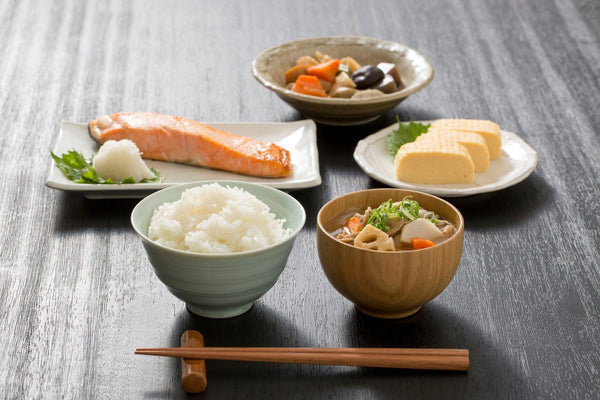
Jump to:
Looking to elevate your morning meal experience? Why not explore the elegant simplicity of a traditional Japanese breakfast?!
Whether you’re an avid breakfast enthusiast or you have a tendency to shy away from the first mealtime of the day, Japanese breakfasts are not to be missed. Steeped in centuries of rich culture and culinary heritage, “asagohan” (朝ごはん) or “choshoku” (朝食) – as breakfast is called in Japanese – offer a fascinating insight into Japanese life as well as an array of benefits for everyday living.
In this in-depth look at Japanese breakfast, we’ll explore its components, cultural significance, modern variations, and even how to recreate this culinary experience at home.
What Is Japanese Breakfast? What Does It Usually Comprise?
Breakfast is an integral part of Japan’s culinary culture. Like all meals (and many other facets of life in Japan), Japanese breakfast reflects the time-honored philosophies of harmony, balance and appreciation for nature. Each item is selected with a purpose in mind – going far beyond just “filling” or providing “energy.” Together these elements create a harmonious blend of flavors, textures and colors.
The key components that are traditionally found on Japan’s breakfast table include:
Rice

At the historical heart of Japanese meals (including breakfast) is rice, an integral component of Japanese cuisine and culture throughout history. More than just sustenance, rice symbolizes prosperity, abundance, and societal progress. The meticulous cultivation and preparation of rice reflect the Japanese reverence for nature and the cycles of life. Today, rice still serves as the foundation of a wholesome breakfast for many Japanese people, though societal trends are seeing some (especially younger) Japanese opt for a mix of traditional and western breakfasts.
Miso Soup

Miso soup is a hallmark of Japanese cuisine, and is often seen on the Japanese breakfast table. It is a flavorful broth made from fermented soybean paste called "miso." The fermentation process of miso preserves the soybean paste and enhances its umami flavors and nutritional value. The presence of miso soup at breakfast exemplifies the Japanese tradition of beginning the day with a warm and nourishing dish. Typically, miso soup is enhanced with ingredients like tofu, seaweed, green onions or seasonal vegetables, adding depth and warmth to breakfast.
Yakizakana (Grilled Fish)

Throughout much of Japan’s culinary history, fish has taken center stage as the primary source of protein. Japan's abundant seas and rivers have made fish a vital part of the Japanese diet. Grilling the fish imparts a smoky and savory taste, complementing the rice and balancing against other components of the breakfast. This technique also aligns with the Japanese way of embracing natural flavors and minimalistic cooking methods. Commonly featured fish varieties include salmon, mackerel, sardines, and sea bream. Today, fish can also be seasoned with salt or a savory-sweet glaze like teriyaki and then grilled or pan-fried, offering a delightful combination of taste and nutrition.
Tsukemono (Pickled Vegetables)

A variety of pickled vegetables, known as tsukemono, are served alongside the main dishes in a Japanese breakfast. These pickles come in different flavors, colors, and textures. They also represent a health component, providing balance against the saltiness or sweet characteristics of the other dishes. The color contrast helps bring balance to the visual appeal of the breakfast table. By pickling vegetables, available produce is preserved and food waste is reduced.
Tamagoyaki (Japanese Rolled Omelet)

Tamagoyaki, a rolled Japanese omelet, graces the breakfast table with its harmonized, sweet and savory taste. Made by layering and rolling thin sheets of seasoned beaten egg, tamagoyaki is not only delicious but also visually appealing. The art of making tamagoyaki showcases Japanese precision and attention to detail.
Nori (Roasted Seaweed)

Roasted seaweed sheets, known as nori, are often served during breakfast. They can be enjoyed on their own or wrapped around rice and other ingredients (in maki or onigiri form) for a simple and satisfying combination. Nori's inclusion adds a touch of umami and a briny essence to the meal. The practice of using nori sheets dates back centuries and connects to Japan's rich maritime history and reliance on the seas for sustenance.
Natto (Fermented Soybeans)

Okay, this one’s a bit of a curveball – among Japanese people and non-Japanese alike. In fact, “do you like natto?” is a question that’s frequently asked to people from other countries who visit or live in Japan. Don’t feel badly if you don’t like natto, by the way, and don’t be surprised if your Japanese friend or colleague doesn’t particularly care for it either – though countless natto fans might see this as blasphemy!
Let’s take a step back: What is natto? Natto refers to fermented soybeans, not unlike those that go into the making of miso soup. But natto adds other factors (a “fear factor” for some), in the form of its sticky texture and distinct odor/aroma. Some people love natto, and some people dislike it! In fact, we haven’t come across too many people in the middle ground of “take it or leave it.” Nonetheless, natto is said to have tremendous health benefits, including being rich in nutrients, aiding in digestion, promoting heart health and more.
Not a natto fan? You’re not alone. Love natto? We hear you loud and clearly! And if you haven’t tried natto, by all means give it a go the next time you’re at a Japanese restaurant – or make natto part of your purchase here on Japanesetaste.com.
Traditional Japanese Breakfast: Form, Freshness & Culture

A traditional Japanese breakfast follows the concept of "ichiju sansai" (一汁三菜): a meal with one soup and three side dishes. This approach helps to ensure a well-rounded breakfast that provides essential nutrients and energy to start the day in good form
The cultural significance of the Japanese breakfast goes beyond its culinary delights, reflecting the Japanese values (rooted in both Shintoism and Buddhism) of simplicity, beauty, respect for the environment, and an appreciation for seasonal ingredients.
The practice of using seasonal foods emphasizes the interconnectedness of nature and life. This mindfulness towards the environment and the changing seasons is deeply rooted in Japan.
Moreover, seasonal foods mean that one is eating the freshest food possible (as opposed to frozen or canned from months ago, or imported from food sources across the globe). Some foods are also said to provide “cooling” effects in the hot, humid summer months, and other foods are consumed to “warm up” during the wintertime.
Culture & History Of Japanese Breakfast
Japanese breakfast can be traced back throughout Japan’s rich and storied history.
Rice is said to have been cultivated in Japan as early as 400 BC, during the Jomon period, and a millennium later, rice had become the primary food course in Japanese society.
Rice was often eaten plain, on its own as a meal, and for centuries breakfast was no exception to this. Over time, however, rice began to be paired with other foods.
By the Edo era (1603-1868) Japanese people enjoyed more complex breakfasts, including rice, fish, and pickled vegetables. Culinary traditions evolved as society became more advanced, and with the Meiji Restoration starting in 1868, this island nation’s food culture began to see an influence from trade with other countries in Asia, Europe and elsewhere.
Modern Japanese Breakfast Foods
While traditional Japanese breakfast remains a cherished culinary practice, modern lifestyles have given rise to some adaptations and contemporary breakfast choices. Popular modern Japanese breakfast foods include:
Onigiri (Rice Balls)

Onigiri have become a staple for busy individuals seeking a quick and portable breakfast. These triangular or cylindrical rice balls are often filled with savory ingredients like pickled plums, salmon, seasoned seaweed… even natto! While it’s healthier to make onigiri at home, many Japanese will grab an onigiri or two at the popular konbini (convenience stores) available in just about every neighborhood in which one either lives or works.
Yogurt with Fruit (and/or Granola)

In recent years, yogurt with fruit and granola has gained popularity in Japan as a light and healthy breakfast option. Yogurt itself has been widely available in Japan for decades, and over time it became common to add fresh or frozen fruit on top. But recently, granola in yogurt has gained in popularity. This is an indicator that western breakfast ideas are taking hold in healthier ways (another one being oatmeal).
Western-Style Breakfast

Many Japanese households have, to one extent or another, embraced Western-style breakfasts. This might include eggs (fried or soft/hard boiled), bacon, sausages, toast, pancakes, and more. However, even with this Western touch, many Japanese households continue to cherish traditional breakfast, with the occasional western breakfast enjoyed here and there.
Where To Enjoy Japanese Breakfast
For travelers and those seeking an authentic Japanese experience, numerous establishments across Japan offer traditional breakfasts. Ryokans (traditional Japanese inns) are renowned for their exceptional breakfast spreads that showcase regional delicacies and seasonal specialties. Additionally, some hotels and restaurants in major cities cater to tourists and locals alike with classic Japanese breakfast options.
Exploring local markets, especially those with breakfast stalls, can also provide a glimpse into the diversity of Japanese breakfast culture. This gives visitors to Japan an opportunity to experience a wide range of traditional and regional delights, and can even be a fun way to interact with locals.
Not in Japan? No problem! You’ll find plenty of Japanese breakfast ingredients (and some of the goods with which to cook and serve them) right here on Japanesetaste.com
How To Make Japanese Breakfast At Home?

Recreating the magic of a traditional Japanese breakfast at home allows you to embrace the essence of Japanese culture.
Here's a simple guide to crafting your own Japanese breakfast:
Rice
Cook short-grain white rice (or brown rice, if preferred) according to package instructions. Keep it warm in a covered bowl until ready to serve. If you want to make perfect Japanese rice at home, we have both recipes for cooking it in a rice cooker and in a pot.
Miso Soup
In a saucepan, combine water, dashi (fish or vegetable stock) and miso paste. Bring it to a gentle simmer. Add tofu, seaweed, green onions and/or your favorite vegetables. Allow the flavors to meld for a few minutes – but avoid boiling the miso, as doing this can reduce miso’s nutritional benefits. If you want to learn more about making miso soup at home, we have recipes for red, white, and mixed miso soup on our website.
Grilled Fish
Season your choice of fish with salt or a savory-sweet glaze. Grill it until cooked through and lightly charred.
Pickled Vegetables
Look for tsukemono on Japanesetaste.com or experiment with pickling your own vegetables, such as cucumbers, carrots, or daikon radish.
Tamagoyaki
Beat eggs and season with a touch of sugar, soy sauce, and mirin (sweet rice wine). Pour a thin layer of the egg mixture into a rectangular pan, cook until set but still slightly runny, then roll it to one side. Repeat the process with additional layers until the omelet is fully cooked and rolled.
Presentation
Once the components are all prepared, it’s not really a Japanese breakfast until the presentation is properly addressed! Arrange the dishes on a tray or individual plates, paying attention to aesthetics and creating a balanced spread.
Accompany your Japanese breakfast with a cup of green tea (sencha or matcha) to complete the experience.
Much of a Japanese breakfast can be prepared with ingredients found in your local supermarkets – and then augmented with a variety of quality Japanese foods and cookware available on Japanesetaste.com
Embracing Japanese Breakfast: In Japan & Around The World

A traditional Japanese breakfast is a profound journey into the heart of Japan's culinary history and culture.
Meticulous preparation, diverse components and a rich tradition of cuisine make Japanese breakfast a unique and soulful experience. As you take in the flavors and appreciate the aesthetics, you are embracing the essence of Japan – a culture that finds harmony in nature, values simplicity and looks for balance in daily life.
Whether you enjoy a traditional Japanese breakfast at a ryokan or recreate it in your kitchen, this culinary adventure will leave a lasting impression on your palate and in your heart.
Looking for ingredients to put into your Japanese breakfast? We’ve got you covered here at Japanesetaste.com. Shop our site to find a wide array of breakfast foods (and ingredients for other meals of the day, of course) as well as cookware and much more – all shipped worldwide from the trusted source for the best of Japan!
Have you tried Japanese breakfast before? What did you think about it? Let us know in the comments below!


0 comments